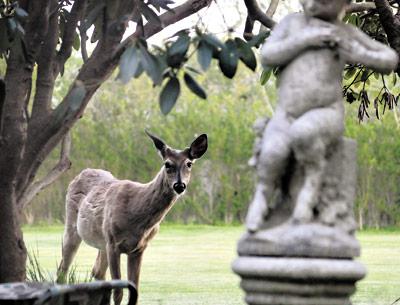Suit Aims to Stop Deer Harvest

Stating that the East Hampton Town Board is acting “arbitrarily and capriciously without scientific and evidentiary support” in its plan to reduce the deer population this winter, several local residents as well as the East Hampton Group for Wildlife and the Evelyn Alexander Wildlife Center of the Hamptons took action last week to halt the deer cull planned for this winter.
The town, the East Hampton Town Trustees, and the Village of East Hampton are named in a lawsuit filed by the New York law firm Devereaux, Baumgarten on behalf of opponents of the deer plan. The town was served on Dec. 18, the village last Thursday. On Friday, the village board voted unanimously to move ahead with the plan. (A story on that appears elsewhere in today’s paper.)
“In 2012, a scientific survey of the deer population” in the town put their number at 877, according to the lawsuit (the survey actually took place on March 9, 2013). Given the count of 3,293 concluded in a town-commissioned survey in 2006, the plaintiffs complain that the assertion of an “uncontrolled explosion in the deer population” is not supported. A statement in the deer management plan that “we have too many deer,” the complaint says, is “unfounded, unsupported by science, reason, and the evidence.”
The complaint challenges the validity of the plan itself, disputing a causal relationship between deer and the prevalence of Lyme disease, and citing statistics on deer populations and Lyme disease in other parts of the state that do not support such causality. It also disputes the town’s claim that deer-vehicle collisions have increased over the past decade.
“The facts are not there: You can’t say that there’s an explosion in the deer population,” Edward Lebeaux of Devereaux, Baumgarten said on Monday.
The governing bodies named in the complaint are compelled to file an answer within 20 days. “If they don’t,” Mr. Lebeaux said “there can be a default rendered against them.” His firm is seeking all documentation and evidence the town used to inform its deer management plan, including medical records pertaining to Lyme disease and data on automobile accidents.
“Statistics show that the [2013 deer] count was down by 70 percent,” Mr. Lebeaux said. “How can it be down and they’re using the term ‘epidemic?’ Their own survey says 877. Those are numbers that are arbitrary and capricious.” Mr. Lebeaux said he was confident that the plaintiffs would prevail in halting the town and village’s culling plans.
Larry Cantwell, the incoming town supervisor, had not seen the lawsuit as of Monday and would not comment on it. But, he said, “I do think there’s a lot of misunderstanding about what the farm bureau is proposing. . . . You’re talking about a fairly limited number of parcels on a townwide basis that this program is going to apply [to]. The farm bureau is asking municipalities to identify parcels and obtain permission from property owners where this might occur. As a result of that, any target hunting that takes place is going to be on a fairly limited number of parcels. The question becomes how much interest is there from private property owners, especially farmland owners in places like Town Lane, Long Lane, other places where there are large herds of deer. There’s a ways to go with this.”
Linda Riley, the village attorney, said on Monday that she had not seen the lawsuit and could not comment on it except to say that the village would likely hire an outside attorney to address it. “But I’ll take a look at it first,” she said.
Diane McNally, the clerk of the trustees, said on Monday that she was surprised that the trustees were named in the suit. “We had asked a year or more ago that a deer management plan exclude any trustee property, only because . . . it’s easier to have our property exempt. I’m not sure these folks who initiated this were aware of that,” she said.
The trustees manage the town’s common lands, including beaches and waterways, on behalf of the public. Ms. McNally said that John Courtney, the trustees’ attorney, received a copy of the suit last week and would likely contact Mr. Lebeaux so that “he can explain who we are and what we do.”
